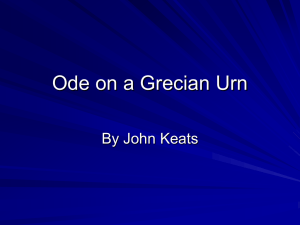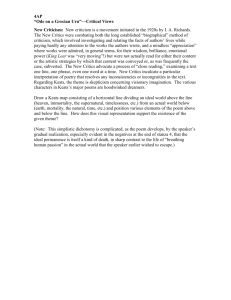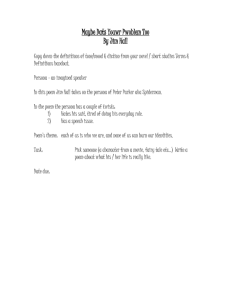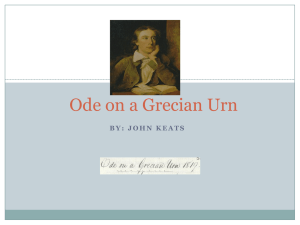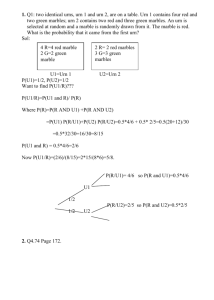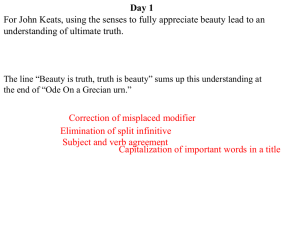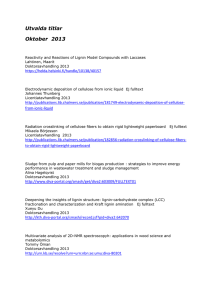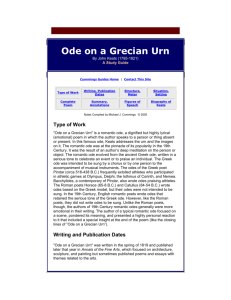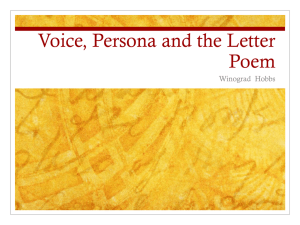Ode On a Grecian Urn - Textual Conversations 2015
advertisement
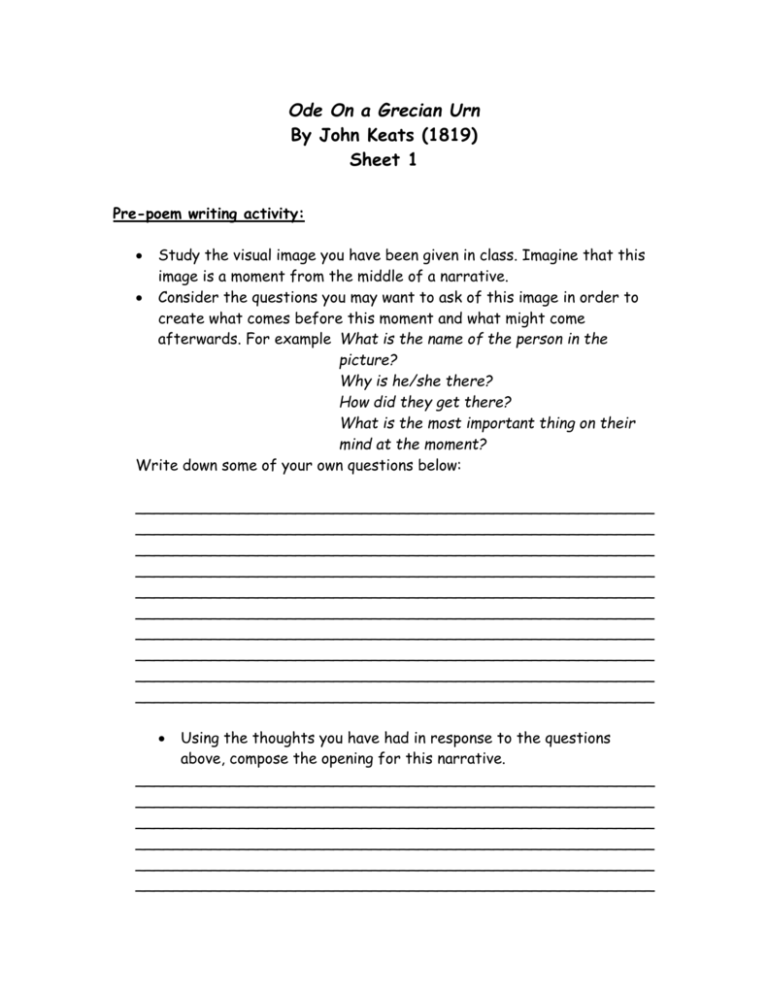
Ode On a Grecian Urn By John Keats (1819) Sheet 1 Pre-poem writing activity: Study the visual image you have been given in class. Imagine that this image is a moment from the middle of a narrative. Consider the questions you may want to ask of this image in order to create what comes before this moment and what might come afterwards. For example What is the name of the person in the picture? Why is he/she there? How did they get there? What is the most important thing on their mind at the moment? Write down some of your own questions below: _______________________________________________________ _______________________________________________________ _______________________________________________________ _______________________________________________________ _______________________________________________________ _______________________________________________________ _______________________________________________________ _______________________________________________________ _______________________________________________________ _______________________________________________________ Using the thoughts you have had in response to the questions above, compose the opening for this narrative. _______________________________________________________ _______________________________________________________ _______________________________________________________ _______________________________________________________ _______________________________________________________ _______________________________________________________ _______________________________________________________ _______________________________________________________ _______________________________________________________ _______________________________________________________ _______________________________________________________ _______________________________________________________ _______________________________________________________ _______________________________________________________ _______________________________________________________ _______________________________________________________ _______________________________________________________ _______________________________________________________ _______________________________________________________ _______________________________________________________ What did you find problematic about the process undertaken above? _______________________________________________________ _______________________________________________________ _______________________________________________________ _______________________________________________________ _______________________________________________________ _______________________________________________________ _______________________________________________________ _______________________________________________________ _______________________________________________________ _______________________________________________________ Ode On a Grecian Urn By John Keats (1819) Sheet 2 (homework) Background contextual reading: John Keats was born in London as the son of a successful livery-stable manager. He was the oldest of four children, who remained deeply devoted to each other. Thomas, his father, was the chief hostler at the Swan and Hoop. After their father died in 1804 in a riding accident, Keats's mother, Frances Jennings Keats, remarried but the marriage was soon broken. She moved with the children, John and his sister Fanny and brothers George and Tom, to live with her mother at Edmonton, near London. She died of tuberculosis in 1810. At school Keats read widely. He was educated at the progressive Clarke's School in Enfield. Keats, who was barely five feet tall, was not known at school for his enthusiasm for books, but his fighting. "My mind has been the most discontented and restless one that ever was put into a body too small for it," he wrote. Keats's first book, Poems, was published in 1817. Sales were poor. He spent the spring with his brother Tom and friends at Shankin. It was about this time Keats started to use his letters as the vehicle for his thoughts on poetry. They mixed the everyday events of his own life with comments with his correspondence. Endymion, Keats's first long poem appeared, when he was 21. It told in 4000 lines of the love of the moon goddess Cynthia for the young shepherd Endymion. Although the critical reaction was lukewarm, Keats was not discouraged by it, but wrote to Richard Woodhouse: "I am ambitious of doing the world some good: if I should be spared that may be the work of mature years - in the interval I will assay to reach to as high a summit in Poetry as the nerve bestowed upon me will suffer." Keats's greatest works were written in the late 1810s, among them Lamia, The Eve of St. Agnes, the great odes and two versions of Hyperion. He worked briefly as a theatrical critic for The Champion, spent summer of 1818 touring the Lakes, Scotland and Northern Ireland. During his journey, which he made with his friend Charles Brown, a businessman, he vowed: "I shall learn poetry here and shall henceforth write more than ever." After returning to London he spent the next three months attending his brother Tom, who was seriously ill with tuberculosis. After Tom's death in December, Keats moved to Hampstead to live with Charles Brown. Soon he fell in love with Fanny Brown, the daughter of a widowed neighbor, and they were betrothed.89 His famous poem 'Ode on a Grecian Urn' was inspired by a Wedgwood copy of a Roman copy of a Greek vase. Josiah Wedgwood's copy was purchased by Sir William Hamilton, who sold it to the duchess of Portland. She denoted the vase to the British Museum in 1784. 'Beauty is truth, truth beauty,' - that is all Ye know on earth and all ye need to know. (from 'Ode on a Grecian Urn') In 1820 appeared the second volume of Keats poems. It gained a huge critical success. However, Keats was suffering at that time from tuberculosis. His poems were marked with sadness partly because he was too poor to marry Fanny Brawne. Keats broke off his engagement and began what he called a "posthumous existence." In a letter from 1819 he had written. "I love you more in that I believe you have liked me for my own sake and nothing else. I have met with women whom I relay think would like to be married to a Poem and given away by a Novel." When his condition gradually worsened, he sailed for Italy in September with the painter Joseph Severn, to escape England's cold winter. He died in Rome at the age of 25, on February 23, 1821, and was buried in the Protestant Cemetery. Keats did not invent his own epitaph, but remembered words from the play Philaster, or Love Lies-Ableeding, written by Beaumont and Fletcher in 1611. "All your better deeds / Shall be in water writ," one of the characters says. Keats told his friend Joseph Severn that he wanted on his grave just the line, "Here lies one whose name was writ in water." (Source: http://www.kirjasto.sci.fi/jkeats.htm) Ode, a form of lyric verse ‘Ode on a Grecian urn’ is a type of lyric verse; an Ode. Find and write a definition for both Lyric verse: _______________________________________________________ _______________________________________________________ _______________________________________________________ _______________________________________________________ _______________________________________________________ Ode: _______________________________________________________ _______________________________________________________ _______________________________________________________ _______________________________________________________ _______________________________________________________ Ode On a Grecian Urn By John Keats (1819) Sheet 3 Matching Exercise: Each of the paragraphs below gives a simple analysis of one of the stanzas of ‘Ode on a Grecian Urn’. They are not in the correct order. Read each and decide which stanza of the poem is being described. The persona is happy to rely on imagination over objective reality, in fact, believes that imagining the answers to his questions is a preferable thing to reality. He begins to envisage the scene. He describes a youth beneath a tree who is about to kiss his lover. The persona laments that this will never happen as the moment is frozen in time. Paradoxically, the poet also sees this as a positive thing as well as their youthful love will never change or fade. Applies to stanza ________________ The persona observes the urn as a whole and thinks back over his visions and recalls his experience of the life depicted on the urn via his imagination. He comments that the urn has possibly misled him by drawing him into its world, while enticing because it is ideal and unchanging, it is nonetheless neither real nor fulfilling. The final couplet in this stanza indicates something about what the poet may have learned about art from his imaginative journey into the world of the urn. Applies to Stanza ______________ The persona seems content to see only the positive side of this frozen moment on the face of the urn. The existence of life on the urn is seen to be preferable to that of the reality of human emotion which constantly changes. The persona believes he can share in the life depicted on the urn via imagination and because the scene of the urn is unchanging. Applies to Stanza ______________ The persona is gazing at the urn and wondering about the images that can be seen on its surface. The questions are wide ranging and indicate the persona’s confusion about the reality and meaning of the images themselves. The questions are addressed to the urn itself but the poem concludes that the urn knows the answers but cannot speak. The persona lacks the objective truth or reality and must rely on his imagination when it comes to his queries. Applies to stanza________________ The mood changes in this stanza to one, again, of desolation and questioning. The persona sees new figures and scenes of bucolic, small village life, of animal sacrifice and the many people attending this religious ceremony. He wonders what places these people have come from and laments the fact that the streets of their villages and town will be forever empty and silent in this frozen moment. Applies to Stanza ______________ Ode On a Grecian Urn By John Keats (1819) Sheet 4 Answer the following questions: Stanza I 1. Who is the poem addressing in the first stanza? What words reveal this to the responder? 2. Who is the ‘Sylvan Historian’ and why can he tell “A flowery tale more sweetly than our rhyme.’’? 3. How is a sense of rapid movement and excitement created in lines 810? 4. What paradoxes exist in this first stanza? Stanza II 5. The first four lines of this stanza contrast the ideal and the real. i. Express these contrasts in your own words. ii. Which would the persona seem to prefer at this stage of the poem, the ideal or the real? How can you tell? 6. In the last six lines of the poem the persona appears to be admiring the ability to remain unchanged over time as conveyed by the figures on the urn, but there is a negative undertone to this declaration. How is this established? Stanza III 7. What attitude does the persona have towards real life passion in the last three lines of the poem? How have language choices revealed this attitude to the responder? Stanza IV 8. How does this stanza construct the idea that the persona is removing himself from his emotional participation in and identification with life on the urn? Stanza V 9. What aspect of the urn is emphasised in the phrases ‘marble men and maidens’, ‘silent-form’ and ‘cold pastoral’? 10. The persona accuses the urn with the line ‘Thou, silent form, dost tease us out of thought/as doth eternity’. What effect does the persona believe the urn has on one’s mind? 11. In the final couplet, the urn seems to be speaking to the responder and communicating the notion that the idea of truth and beauty are both synonymous and reciprocal. How does the persona respond to this notion? I s such a notion supported in the rest of the poem? Paragraph responses: 1. Discuss how the poem explores the ability of art (poetry) to stir the imagination. Discuss both ideas and techniques. 2. Discuss how the poem explores the relationship between art and the artist’s perception of the world. Discuss both ideas and techniques. (adapted from: http://englishhistory.net/keats/poetry/odeonagrecianurn.html)
